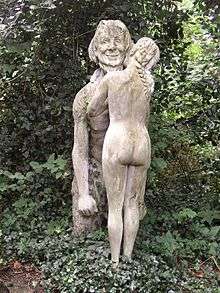Bugbear
A bugbear is a legendary creature or type of hobgoblin comparable to the bogeyman (or bugaboo or babau or cucuy), and other creatures of folklore, all of which were historically used in some cultures to frighten disobedient children.[1]

Etymology
Its name is derived from the Middle English word "bugge" (a frightening thing), or perhaps the Old Welsh word bwg (evil spirit or goblin),[2] or Old Scots bogill (goblin), and has cognates in German bögge or böggel-mann (goblin), and most probably also English "bogeyman" and American English "bugaboo".
In medieval England, the bugbear was depicted as a creepy bear that lurked in the woods to scare children. It was described in this manner in The Buggbears,[2] an adaptation, with additions, from Grazzini’s La Spiritata (‘The Possessed [Woman]’, 1561).[3]
In a modern context, the term bugbear may also mean pet peeve.[4]
In popular culture
Bugbears appear in a number of modern fantasy literature and related media, where they are usually minor antagonists.[5] They also appear as monsters, described as large, hairy goblinoids, in the canon of popular fantasy role-playing games.[6][7]
The My Little Pony: Friendship is Magic episode "Slice of Life" features a bugbear, portrayed as a literal hybrid of a bear and a bee.
See also
- Moss people
- Sprite (creature)
- Wirry-cow
- Yōkai
References
| Look up bugbear in Wiktionary, the free dictionary. |
- J. Simpson; E. Weiner, eds. (1989). "Raven". Oxford English Dictionary (2nd ed.). Oxford: Clarendon Press. ISBN 0-19-861186-2.
- Briggs, Katherine M. (1976). A Dictionary of Fairies. Harmondsworth, Middlesex: Penguin. p. 52. ISBN 0-14-004753-0.
- Bond, R. Warwick. "Early Plays from the Italian" (PDF). warburg.sas.ac.uk. Retrieved 2019-01-07.
- "Definition of BUGBEAR". www.merriam-webster.com.
- Jon Saklofske; Alyssa Arbuckle; Jon Bath (10 December 2019). Feminist War Games?: Mechanisms of War, Feminist Values, and Interventional Games. Taylor & Francis. p. 73. ISBN 978-1-00-075120-8.
- "Bugbear - Pathfinder Wiki". Pathfinder Wiki. Retrieved 24 May 2020.
- "Bugbear - D&D Beyond". D&D Beyond. Retrieved 24 May 2020.